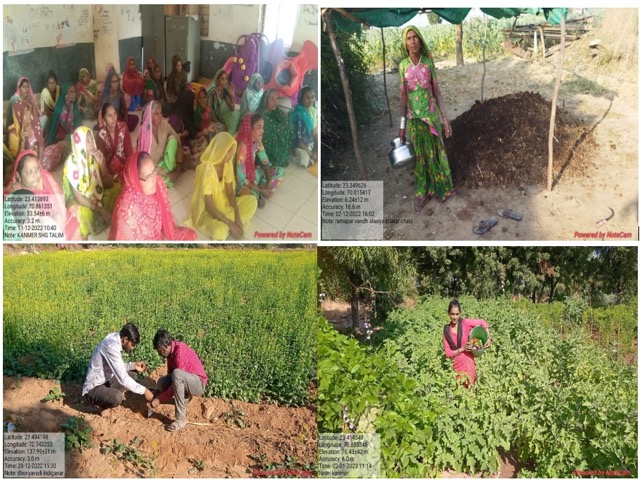Case Study – Nutri Kitchen Garden in the dry arid zone of Rapar
Author – Ms. Rajul Bharti,CEO, Samerth Charitable Trust
Kutch is the second largest district of India, with sea on one side, desert on the other and land on the third. Kutch is now a popular tourist destination, but Rapar- a block in Kutch, is not a tourist hub. It is a dry, arid zone – also known as the dark zone since the ground water extraction is as high as 90 – 100%. The ground is saline, due to its closeness to the desert.
 It is not surprising then, that 30% population in Rapar (total population is 2,17,315 (2011 census), 30% is roughly 65,194) is from the marginalized communities – OBCs, SCs and STs (Rabari, Koli, Harijan etc). Monsoon is erratic and though the average rainfall of Kutch is 377mm – it occurs within a span of few days, and less than 4% of the rainwater can be collected.
It is not surprising then, that 30% population in Rapar (total population is 2,17,315 (2011 census), 30% is roughly 65,194) is from the marginalized communities – OBCs, SCs and STs (Rabari, Koli, Harijan etc). Monsoon is erratic and though the average rainfall of Kutch is 377mm – it occurs within a span of few days, and less than 4% of the rainwater can be collected.
The SCs and STs – mainly Kolis and Harijans live in Vandhs. Vandhs, are settlements carved out of the village in deep desert lands. In Rapar like in other places, usually the land closest to water sources almost always belongs to the upper and the more powerful castes. The Kolis and harijans feature at the bottom of caste (power) hierarchy and hence have lands in areas with no water source and far away from the main village. Coupled with the ridicule that they face in the village, Kolis since generations decided to set up their homes near their lands. As the family grows, a settlement is formed – and this is called a Vandh. Out of village and administration’s direct purview, Vandhs have poor health and education facilities as well as road connectivity.
Poor families typically survive on millet or grain bread, garlic/onion and chilli mix. Pulses or potatoes are sometimes eaten as accompaniments but green vegetables are a rarity. Typically, women who are responsible for all domestic work, along with fetching water from water bodies, raise children, work on their farms prioritize themselves after everyone in else in the family for nutrition. This impacts their overall health. This is reflected in women’s health at all stages. In adolescent girls – painful, heavy flow, health indicators of pregnant women* – poor weight gain during pregnancy, low birth weight of child, poor milk production and rampant anemia. In older women we found poor health during menopause especially detoriation in bone density and poor immunity (Source: Discussions with doctors from local Primary Health Centres, Asha workers, Aganwadi workers and discussions with community women).
Women, thus face a double marginalized – being born in an extremely marginalized community and then facing vulnerability due to their gender. A difficult geography and restrictive social norms leading to further marginalization – directly reflective on their health.
Samerth Trust works in Rapar focusing on communities, facilitating construction of more than 1000 ponds, wells, Rain roof water harvesting structures for the poorest families. Samerth in Partnership with WIN Foundation works with the most marginalized women and supports them in growing nutritious green vegetables based on their soil and water capacities. Women are also encouraged and supported to initiate vermicomposting and use the manure for their farms. These women are then capacitated to understand the importance of nutrition – focusing on the women’s health and how nutrition during adolescence and pregnancy is directly related to fetus health and her changing health requirements as she grows older. These interactions gave rise to newer dialogues on importance of nutrition in women – post their child bearing age.
Women groups visit nursery and farms of individuals to learn successful practices of vegetable cultivation in the arid weather of Kutch. They are provided with seeds and sapling of vegetables based on their soil, water analysis, their own interest and food consumption pattern. 5 months into the programme, we see women growing vegetables and have now started consuming fresh vegetables at least once a day. Some have had excess and have started selling in and around their own area.

(From top to bottom, left to right women trained in groups, vermicomposting, soil testing and vegetable harvesting)
It is now too early to compare their health indicators with increase in their nutritional intake, but it is expected that that by the end of year this initiative will show demonstrable results. Already, women not part of the initiative are getting interested and have tried to sow vegetable seeds in the kitchen garden on their own.
The initiative is aimed to propose a new alternative to the persistent issue of nutritional health of women – especially in remote areas with poorest women in difficult geographies. Such initiatives combined with the Government’s support on the various nutrition related schemes should help to bring in sustainable change.
A short clip of one of our nutri kitchen women click here
*A quarter of women of reproductive age in India are undernourished, with a body mass index (BMI) of less than 18.5 kg/m (Source: NFHS 4 2015-16). It is well known that an undernourished mother inevitably gives birth to an undernourished baby, perpetuating an intergenerational cycle of undernutrition.”

